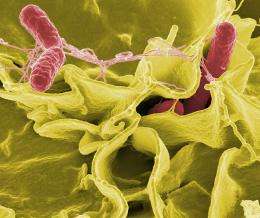Avoiding nasty germs and flaming turkeys on Thanksgiving

People like to gripe about overly dry turkey on Thanksgiving. But nothing’s worse than a bird that goes up in flames.
Ernest Grant, RN, MSN, director of burn prevention and community outreach at the North Carolina Jaycee Burn Center, said that UNC Hospitals admits one or two people each Thanksgiving with burns related to deep-frying a turkey. Deep-fried-turkey mishaps have also caused local house and garage fires, he said.
Last year, Underwriters Laboratories, a consumer product safety organization, declined to endorse any turkey fryers because of widespread safety problems. For example, many fryers tip over easily, spilling dangerously hot oil. Most units don’t have thermostats, which means that oil can overheat and catch fire. Watch fryers catch fire in this Underwriters Laboratories video:
Some people fail to completely thaw a turkey before placing it in a fryer, Grant said. Because oil and water don’t mix, placing a frozen turkey in a fryer can cause ultra-hot grease to bubble all over the place.
“If done properly, you get a very nice, tasty bird,” he said. But to avoid serious injury or property damage while deep-frying a turkey, you must use extreme caution.
To stay safe, Grant said it’s wise to leave deep-frying to the professionals. For example, Bojangles' and several grocery chains offer fried turkeys that can be ordered for the holiday.
If you’re determined to fry the turkey yourself, Grant offered these safety tips:
• Make sure the turkey is completely thawed and patted dry.
• Use peanut or cotton seed oil, which can tolerate very hot temperatures.
• Even though it’s likely to be cold on Thanksgiving, cook the turkey outside, such as on a driveway away from other objects. Don’t use the fryer in a garage or on a wooden deck or patio.
• Fryer handles can get extremely hot, so use oven mitts while you’re handling it.
• Even if you’re cooking a turkey the traditional way, you should still take precautions, Grant said. For example, some people use a flimsy aluminum pan to bake a turkey. Such pans can bend when you take them out of the oven, spilling hot juices on your hands and wrists.
To avoid cooking injuries, Grant advised following these steps:
• Wear oven mitts that go past the wrist to protect your hands and arms from spills.
• Create a “safety zone” that extends three feet in front of the oven. Tell young children not to enter that zone while the oven is on.
• Leave plenty of time for cooking so that you don’t need to rush.
• Keep a small fire extinguisher near the stove.
• If a pan catches fire, cover it with a lid to starve the fire of oxygen. Turn off the stove. Don’t try to take the pan outside, because you could trip or injure another person.
• If you’re not able to extinguish a fire within 30 seconds, it’s time to leave and call 911.
Salmonella in the stuffing
Another health hazard on Turkey Day is the bacteria lurking in your bird.
You should assume that any raw fowl contains salmonella, said David Weber, MD, MPH, professor of infectious diseases and pediatrics in the UNC School of Medicine, and professor epidemiology in the UNC Gillings School of Global Public Health.
Yes, turducken lovers – that means that your turkey, duck and chicken may each be contaminated.
To reduce your risk, follow these steps.
• Every time you cut raw meat on a cutting board or plate, disinfect it before you use it to cut items that will not be cooked. Put it in the dishwasher or wash it with a disinfectant.
• Avoid using a cutting board with a porous surface, such as wood.
• Prepare vegetable dishes, such as salads, before you handle the meat to avoid cross-contamination.
• Defrost the turkey in the fridge, not on the counter. Defrosting may take 24 hours or longer, so buy your turkey in advance.
• Use a meat thermometer to make sure the bird reaches the proper temperature: 165 degrees for at least five minutes. Make sure you avoid touching bone with the thermometer.
• Once the turkey is cooked, remove the stuffing and serve it separately. Stuffing is a more hospitable place for bacteria to grow than the turkey itself, Weber said.
• Don’t leave the turkey out on the counter. Cut it into pieces and put it back in the refrigerator. Keep in mind that bacteria populations can double in size every 20 minutes, Weber said. That means that after six hours without refrigeration, leftovers can contain millions of bacteria.
Cheese, cream and butter on your plate
Whew! You’ve cooked your turkey safely. Now, what can you do to ensure that your side dishes are healthy?
Susannah Southern, RD, LDN, an outpatient dietitian in UNC’s Department of Family Medicine, said the basics of a Thanksgiving dinner – lean turkey meat plus vegetable sides – are actually pretty nutritious.
“We tend to mess those up by adding a lot of extra calories from cheese and cream and butter,” she said.
She advises turning a skeptical eye toward the amount of fat and sodium in recipes.
“Look at a recipe, and if it calls for a half stick of butter, you can probably use a quarter,” she said. If a recipe calls for canned soup or broth, you can substitute a low-sodium and low-fat version. (Caution: Altering baked-good recipes can be tricky. You may want to consult a low-fat baking guide.)
“Those things can cut your calories and sodium by a third or more, but you still have something pretty tasty,” she said.















